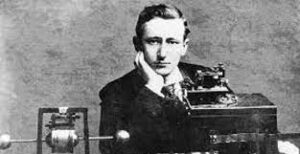Guglielmo Marconi Biography

BIRTH: April 25, 1874 Bologna, Italy
DEATH: July 20, 1937 (aged 63)
Rome, Italy
Guglielmo Marconi Biography : Inventions, Radio, & Facts
Guglielmo Marconi was an Italian engineer, physicist and inventor. Marconi successfully invented the long-distance wireless telegraph and the radio signal. He majorly contributed to the development of the radio and won the Nobel Prize in Physics in 1909.
Guglielmo Marconi was born in 1874 in Bologna, Italy to Giuseppe Marconi and Anne Jameson. Both his parents were working. His family had to travel a lot due to their silk business. During these trips, Marconi was tutored by different people. For the first few years, he was educated privately in Bologna. He studied languages. Marconi started to read various books on science and electricity. He completed his education at the Livorno Technical Institute and then went to the University of Bologna. He developed an interest in the field of electricity at a very young age. He performed many experiments in a small room in his house. After he completed his education, he entirely focused on his electricity-related projects. His family was very supportive of his interests, especially his mother.
Marconi’s work was heavily influenced by Heinrich Hertz. He was amazed by Hertz’s discovery of invisible waves, created by electro magnetic interactions called ‘Hertzian waves’. Marconi was only fourteen when he first heard of Hertz’s work.
In 1895, he developed a communication model which made wireless radio signaling possible. So, he set up a laboratory in his father’s home for his experiments. His university professor helped Marconi with his experiments. At the age of 21, he performed his first successful experiment. He sent different signals over a distance of more than one mile.
At the age of 22, Marconi traveled to England with his mother. He found some interested sponsors for his experiments. One of them was the British Post Office. London was the commercial and financial hub of England. He wanted to show his experiments to the public who could buy them. Marconi met Preece, who was impressed by his experiments and decided to help him financially.
Marconi performed the first experiment on the rooftops of two buildings in London, which was a success. In 1896, Marconi got the patent for wireless telegraphy. The same year, he decided to open his own company. With the help of his family, he started Wireless Telegraphy & Signal Company Limited. Marconi built the first radio station of the world in 1897. And the next year, he created the world’s first wireless telegraph factory in England.
At the end of the eighteenth century, Marconi sent signals across the English Channel and established wireless communication between France and England. In 1901, he sent the most powerful radio signal broadcast. He made an antenna attached to a balloon. He was the first person to pick up the faint three-dot sequence of the Morse code letter ‘s’. In 1908, Marconi set up a service to send telegrams between the UK and Canada. It was the first commercial use of wireless services.
In 1909, he was awarded the Nobel Prize in Physics, which he shared with Ferdinand Braun. Marconi had many of his inventions patented; one being the ‘magnetic detector’. It was used as a standard wireless receiver for many years.
In the beginning, most of Marconi’s inventions were rejected by the Italian government. The Italian government later realized how they had failed to respect such a great scientist.
Marconi also served in the Italian navy army as a lieutenant. During World War I, he and helped the military with his wireless services.
He started developing the shortwave radio technology. He called it the ‘Marconi Radio’ and installed it on ships.
For his significant contribution to science and technology, he was not only awarded the Nobel Prize in Physics but was also honored with the Albert Medal, the Kelvin Medal and the John Fritz Medal.
Marconi married twice and was the father of five children. He died on July 20, 1937, at the aged of 63, after he suffered from multiple heart attacks. As a tribute, radio stations in America, England and Italy broadcasted a few minutes of silence for the great inventor.
- What is meant by Database Management System?
- Discuss the advantages and drawbacks of database.
- What do you mean by database ? Discuss its Characteristics.
- What is Data Mining?
- What are the conditions of communication?
- What do you mean by business communication ?
- organization / Differentiate between classical and modern theory of organization
- What is forecasting






